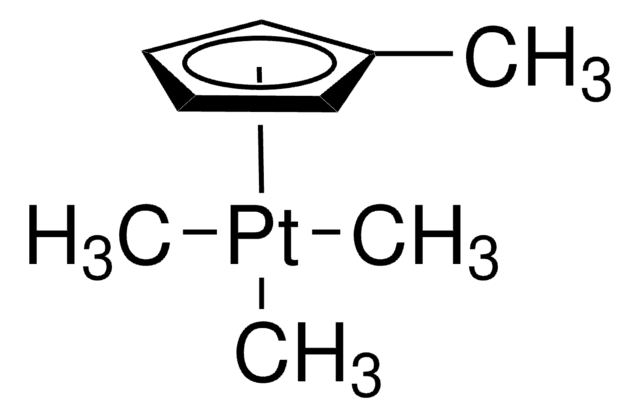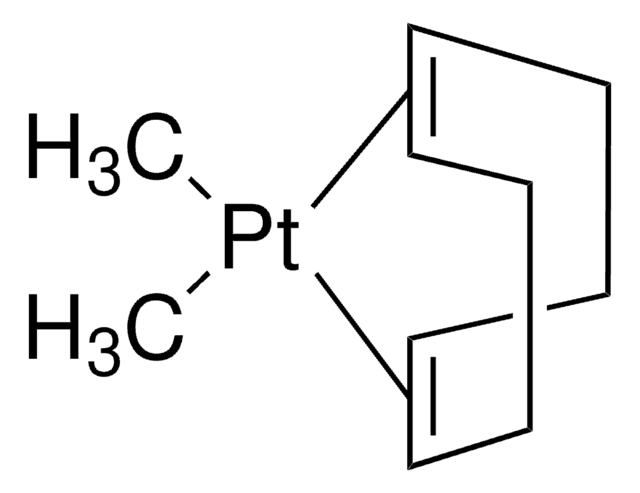Wichtige Dokumente
523038
Platin(II)-acetylacetonat
≥99.98% trace metals basis
Synonym(e):
2,4-Pentandion Platin(II)-Derivat, Pt(acac)2
Größe auswählen
About This Item
Empfohlene Produkte
Qualitätsniveau
Assay
≥99.98% trace metals basis
Form
solid
Eignung der Reaktion
core: platinum
mp (Schmelzpunkt)
249-252 °C (lit.)
SMILES String
CC(=O)\C=C(\C)O[Pt]O\C(C)=C/C(C)=O
InChI
1S/2C5H8O2.Pt/c2*1-4(6)3-5(2)7;/h2*3,6H,1-2H3;/q;;+2/p-2/b2*4-3-;
InChIKey
KLFRPGNCEJNEKU-FDGPNNRMSA-L
Suchen Sie nach ähnlichen Produkten? Aufrufen Leitfaden zum Produktvergleich
Verwandte Kategorien
Allgemeine Beschreibung
Anwendung
- Pt−Co octahedral nanocrystals, which are used to improve catalytic activity and durability in the oxygen reduction reaction (ORR) in fuel cells.
- PtW@WO3 NPs via thermal decomposition method, serving as efficient catalysts for the hydrogen evolution reaction (HER).
- Monodisperse Pt–Fe nanoparticles, which exhibit high durability for proton exchange membrane fuel cells and provide active and durable low-Pt electrocatalysts for electrochemical devices.
Leistungsmerkmale und Vorteile
- High Purity: Reduces contamination risk, ensuring reliable performance in applications.
- Thermal Stability: Maintains activity at elevated temperatures, enhancing product lifespan and efficiency.
- Soluble in acetone
- Elemental Carbon is >29.5% and Platinum presents >47.9%
Signalwort
Warning
Gefahreneinstufungen
Acute Tox. 4 Dermal - Acute Tox. 4 Inhalation - Acute Tox. 4 Oral - Eye Irrit. 2 - Repr. 2 - Skin Irrit. 2 - STOT SE 3
Zielorgane
Respiratory system
Lagerklassenschlüssel
11 - Combustible Solids
WGK
WGK 3
Flammpunkt (°F)
Not applicable
Flammpunkt (°C)
Not applicable
Persönliche Schutzausrüstung
Eyeshields, Gloves, type P3 (EN 143) respirator cartridges
Hier finden Sie alle aktuellen Versionen:
Besitzen Sie dieses Produkt bereits?
In der Dokumentenbibliothek finden Sie die Dokumentation zu den Produkten, die Sie kürzlich erworben haben.
Kunden haben sich ebenfalls angesehen
Artikel
Solvothermal synthesis of nanoparticles: applications from nanocircuits and nano-optical circuits to nanomagnetics and biotech.
Magnetic nanoparticles have attracted tremendous attention due to their novel properties and their potential applications in magnetic recording, magnetic energy storage and biomedicine.
Aktive Filter
Unser Team von Wissenschaftlern verfügt über Erfahrung in allen Forschungsbereichen einschließlich Life Science, Materialwissenschaften, chemischer Synthese, Chromatographie, Analytik und vielen mehr..
Setzen Sie sich mit dem technischen Dienst in Verbindung.
















